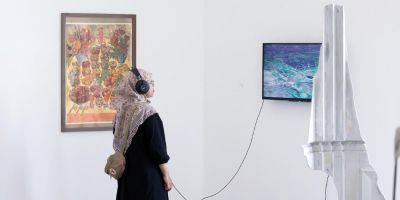Eric Satie’s Vexations for piano meets the reversible record player
Eric Satie’s Vexations for piano meets the reversible record player
CAVE are sorry to announce that this installation and performance has been postponed due to technical reasons. We will be rescheduling the work for mid-March.
A collaboration between musicians and artists at the University of Leeds will showcase an exciting new take on an avant-garde classic by early twentieth-century French composer Eric Satie this month at The Hepworth Wakefield.
Simon Lewandowski and Sam Belinfante from the School of Fine Art, History of Art and Cultural Studies are working with Scott McLaughlin from the School of Music to create a new performance of Satie’s infamous Vexations.
Vexations was composed by Erik Satie in 1893 and is still as challenging a piece of work as anything to come out of the contemporary avant-garde. It consists of a short theme with the instruction to play it on the piano a total of 840 times.
This version will be ‘performed’ by a record-player programmed to play forwards and reverse at controlled but unpredictable intervals that will add up to the 840 repeats the composer calls for in the score. The one-off vinyl recording has nine versions of the theme played by James Telford, repeated in reverse so that they can be heard continuously as the needle goes backwards and forwards.
The record player used is a direct ‘descendant’ of the Reversing Machine which Belinfante and Lewandowski installed in The Tetley gallery in 2014. It not only played records but powered up a chorus of kinetic devices to fill the gallery with light and movement.
Simon Lewandowski said:
“When John Cage and a team of helpers played Vexations in 1963, it took 18 hours and 40 minutes.
“This new version will take just under 24 hours to complete. The record-player will operate in the Calder gallery as a sculptural installation for the first 23 hours starting at 8.30pm on Tuesday 28 March. It will then be open to the public from 11.00am onwards the following day.
“An audience will be invited to attend the final section on the evening of 29 March as ‘witnesses’ of the point at which the piece stops, accompanied by a scratch ensemble of keyboards and other instruments gradually joining in for the last hour.”
The piece will be open to the public from 11.00am on Wednesday 29 March with a performance starting at 7.30pm. See here for more information.
This is the latest in a series of workshop performances organised by the Centre for Audio Visual Experimentation (CAVE) at the School for Fine Art, History of Art and Cultural Studies in partnership with the School of Music. The project is realised with financial support from the Centre for Practice-led Research in the Arts.




